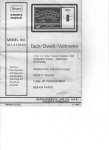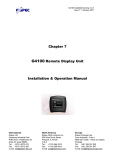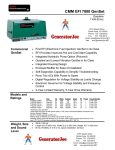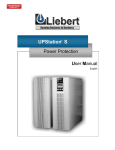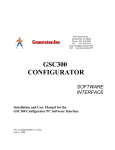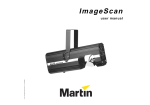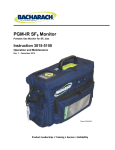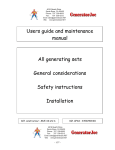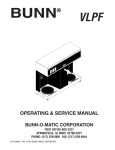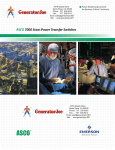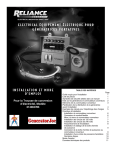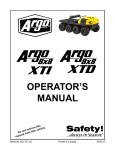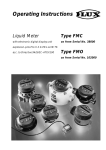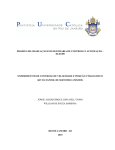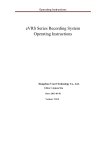Download STANDBY GENERATOR SET
Transcript
STANDBY GENERATOR SET INSTALLATION, OPERATION, & MAINTENANCE MANUAL INDEX Introduction (Pages 2-4 are blank) Safety Pages 6 – 15 Installation Pages 16-18 Exhaust Pages 19-24 Cooling System Pages 25-39 Ventilation Pages 40-43 Fuel System Pages 44-49 Electrical Installation Pages 50-60 Operation Page 61 Maintenance & Service Pages 62-63 Troubleshooting Page 64 Warranty Pages 65-66 5 SAFETY! PLEASE REVIEW THE FOLLOWING BEFORE PROCEEDING WITH INSTALLATION OR OPERATION OF YOUR GENERATORJOE GENERATOR SET. Think Safety first at all times and when in doubt call GENERATORJOE and get additional information before performing installation, operation, service or testing of the generator set. Each section of this manual will have caution! and warning! information, which should be regarded with the utmost care. Repairs should only be done by properly trained personnel and under no circumstances should anyone proceed with a repair when they are not sure of proper procedure. This manual is not intended to be all that is required to properly operate this unit but is merely an aid to performing basic service to keep the unit in proper operating condition. Included with the unit should be an engine operator’s guide and a generator operators guide to assist a generator technician in maintaining the unit. Installation of the unit should be done in compliance with the installation section of this manual. Proper installation in accordance with the National Electric Code, Occupational Safety and Health Administration (OSHA) and local safety codes must be strictly complied with. Proper grounding is essential in preventing possible electrical shock and even death. Remember, safety begins with the owner/operator of the unit. Make sure to keep fingers, hair, jewelry and clothing away from the revolving parts of the generator set such as belts, fan blade and generator rotor fan Operation of the unit should be first done by GENERATORJOE authorized start up personnel so that they make sure the unit was properly installed and is functioning properly with the load system being applied to the unit. The start up personnel will instruct the owner on basic procedures and will answer any questions the owner may have on general operation and maintenance. Before performing routine maintenance, disconnect the unit from the load and disable the control system as discussed in the maintenance section, Disabling the System. Proper maintenance is the primary method of assuring the unit will operate when it is needed. Review each of the sections before proceeding with installation or operation of the GENERATORJOE generator set. The following page lists some of the safety dos and don’ts that everyone should remember. 6 7 8 9 10 11 12 SAFETY DO’S AND DON’TS DO PRACTICE SAFETY; The life you save may be your own DO • Do perform your tasks carefully, without undue haste. • Do provide fire extinguishers (rated ABC). • Do provide a First Aid Kit (for burns and abrasions). Obtain medical attention. • Do use the correct tools for the job you are doing • Do make sure that all fasteners are secure. • Do use extreme care while making adjustments on the generator set while it is running. • Do keep your hands away from moving parts. • Do remember - Horseplay is for horses! It has no place around machinery • Do disconnect batteries before starting work on generator set. • Do use screwdrivers, pliers, diagonal pliers, etc. with insulated handles. • Do remember to keep one hand in your pocket if it is necessary to work on live circuits. To do so will prevent passage of electricity into one hand and out the other, which passes current across the heart. DON'T • Don’t allow inexperienced personnel to work on the generator or electrical equipment. • Don’t remove plastic guards or protective devices. • Don’t wear loose clothing or jewelry in the vicinity of moving parts. These can get in machinery, with disastrous results. Don’t wear jewelry while working on electrical equipment. If your hair is long, wear a head covering. Hair caught in a drill press, fan belt, or other moving parts can cause serious injury. • Don’t stand on a wet floor while working on electrical equipment. Use rubber insulated mats placed on dry wood plat forms • Don’t lunge after a dropped tool. To do so may place you in a position of extreme danger. • Don’t commence any operation until you have taken all the necessary steps to ensure that you are in complete safety. 13 Low Voltage General Safety Precautions Control circuits utilized by the generator set are D.C. voltage. This voltage potential is not considered dangerous, but the large amount of current available (over 300 amps) can cause severe burns if shorted to ground. 1. Use extreme caution if holes are drilled into the generator set. Holes drilled into an electrical wire can cause fire, explosion, or shock hazard. 1. Disconnect the negative terminal of the battery if possible when working on the generator set. Disconnect the cable end that is away from the battery. 2. Be sure all mounting screws are light and are the correct length. 3. Keep tools and equipment clean and in good working condition. Accidents occur when you attempt procedures without the proper tools. 2. Do not wear jewelry, watches, or rings. These items can short out and cause severe burns to the wearer. 14 Safety Precautions Rotating Hazards Keep your hands, clothing and tools clear of the fan and water pump belt when the generator set is running. If it’s necessary to run the generator with the end cover removed, by very careful with tools or meters being used in that area to avoid contacting the rotor. Battery Hazards Few people realize just how dangerous a battery can be. The electrolyte in a lead acid battery is dilute sulphuric acid (H2S04). During charge or discharge functions of a battery, a chemical change takes place within the individual cells that causes the bubbling we see through the filler hole. This gas bubbling is hydrogen and oxygen, and it is EXPLOSIVE. If, during this gassing action, a means of ignition is present, an explosion could occur. A defective battery may suddenly explode even while standing idle. Added to this danger, consider a fall out of highly corrosive sulphuric acid caused by the explosion. A rubber blanket or other cover can be used to reduce the risk from possible explosion. Precautions Always wear eye protection when servicing batteries. If electrolyte is splashed on the skin or in the eyes, flush immediately under running water. Obtain medical help as soon as possible. When charging batteries, do not remove the vent caps. When disconnecting or reconnecting the generator set battery, make sure the on-off switch is in the off position to prevent an arc, which could cause the battery to explode. Disconnect the ground cable first, preferably at a point away from the battery. Reconnect the ground cable last, again away from the battery. Electrical Hazards High Voltage When servicing or repairing a generator set, the possibility of serious or even fatal injury from electrical shock exists. Extreme care must be used when working with an operating generator. Lethal voltage potentials can exist on connections that are in the exciter control box. Precautions When working on high voltage circuits on the generator set, do not make any rapid moves. If a tool drops do not grab for it. People do not contact high voltage wires on purpose. It normally occurs from an unplanned movement. Make sure of your footing. If you slip you will instinctively grab for support. This can be lethal around a generator set. Work on rubber mats or dry wood if possible. Use tools with insulated handles that are in good condition. Never hold metal tools in your hand if exposed, energized conductors are within reach Treat all wires and connections as high voltage until a meter and wiring diagram show otherwise. IMMEDIATE action must be initiated after a person has received an electric shock Obtain expert medical assistance if available. The source of shock must be immediately removed by either shutting down the generator power or removing the victim from the source. If it is not possible to shut off the generator set, the wire should be cut with either an insulated instrument such as a wooden handled axe or cable cutters with heavy insulated handles, or a rescuer wearing insulated gloves. Whichever method is used, do not look at the wire while it is being cut. The ensuing flash can cause blindness. Remember that insulated gloves are manufactured for protection from liquids. If the victim has to be removed from live circuitry, knock him off. DO NOT TOUCH HIM, you could receive a shock from current flowing through his body. After separating the victim and power source, check immediately for respiration and presence of a pulse. If a pulse is present, respiration can be restored by mouth-to-mouth resuscitation. 15 Installation MOUNTING The foundation, floor or roof must be able to support the weight of the generator set and its accessories (such as a sub-base fuel tank), resist dynamic loads and not transmit objectionable noise and vibration. See the generator set Specification Sheet or outline drawing for the weight of the generator set and its mounting points. Vibration Isolators Figure 19 illustrates a steel spring vibration isolator of the type required for mounting the larger GENERATORJOE generator sets even those models which have rubber vibration isolators between the skid and the engine-generator assembly. Steel spring isolators of this type can provide up to 98 percent reduction in the force of the vibration transmitted. Locate the isolators as shown on the generator set outline drawing referenced on the Specification Sheet. The outline drawing may show configurations involving 4, 6, 8, or 12-point mounting. Also, when the generator set is mounted on top of a sub-base fuel tank, the vibration isolators must be installed between the generator set and the fuel tank. Bolting these generator sets directly to the floor or foundation will result in excessive noise and vibration and possible damage to the set, the floor, and other equipment. Smaller GENERATORJOE generator sets have rubber vibration isolators located between the skid and the engine-generator assembly. They may be bolted directly to the foundation, floor or sub-structure. FIGURE 19 TYPICAL STEEL SPRING VIBRATION ISOLATOR 16 Mounting on a Slab Floor When a generator set is mounted on a concrete slab floor, a concrete pad should be poured on top of the floor. The pad should be reinforced concrete with a 28 day compressive strength of at least 2500 psi (173 kPa). It should be at least 6 inches (150 mm) deep and extend at least 6 inches (150 mm) beyond the skid on all sides. Type J or L bolts should be used to anchor the skid or vibration isolators to the pad. Mounting on a Sub-Base Fuel Tank When a generator set is mounted on a sub-base fuel tank, the vibration isolators must be installed between the generator set and the fuel tank. The fuel tank must be able to support the weight of the set and resist the dynamic loads. It is recommended that the tank be mounted such that an air space is included between the bottom of the tank and the floor underneath to reduce corrosion and permit visual inspections for leaks. Mounting on a Vibration Isolating Foundation When a generator set is mounted on a foundation to reduce the transmission of vibrations to the building, the weight (W) of the foundation should be at least 2 times the weight of the set itself to resist dynamic loading. (The weight of fuel in a sub-base fuel tank should not be considered as contributing to the weight required of a vibration isolating foundation.) Figure 20 illustrates a typical vibration isolating foundation. Consider the following: • The foundation should extend at least 6 inches (150 mm) beyond the skid on all sides. This determines the length (L) and width (W) of the foundation. • Calculate the height (H) of the foundation necessary to obtain the required weight (W) by using the following formula: H= W DxLxW Where (D) is the density of concrete, typically 145 lbs / ft3 ( 2322 kg / m3 ). • The foundation should extend at least 6 inches (150 mm) above the floor to make service and maintenance of the generator set easier. • The foundation must extend below the frost line to prevent heaving. • The foundation should be reinforced concrete with a 28 day compressive strength of at least 2500 psi (173 kPa). • The total weight (TW) of the generator set, fuel and foundation usually results in a soil bearing load (SBL) of less than 2000 lbs/ft2 (96 kPa). Although this is within the load bearing capacity of most soils, always find out the allowable soil bearing load by checking the local code and the soil analysis report for the building. Calculate the soil bearing load by using the following formula: SBL= TW LxW Where L and W are the length and width of the foundation. 17 • Type J or L bolts should be used to anchor the skid or vibration isolators to the foundation. FIGURE 20 TYPICAL VIBRATION ISOLATING FOUNDATION 18 EXHAUST SYSTEM The function of the exhaust system is to convey engine exhaust safely to the out-of-doors and to disperse the exhaust fumes, soot and noise away from people and buildings. See Figure 21. Consider the following (also review Location and Noise under Application): • Flexible, corrugated stainless steel exhaust tubing at least 24 inches (610 mm) long must be connected to the engine exhaust outlet(s) to take up thermal expansion and generator set movement and vibration whenever the set is mounted on steel spring isolators of the type shown in Figure 19. Smaller sets that are bolted directly to the floor must be connected by corrugated stainless steel exhaust tubing at least 18 inches (457 mm) long. Flexible tubing must not be used to form bends or to compensate for misaligned piping. • To reduce corrosion due to condensate, a muffler should be installed as close as practical to the engine so that it heats up quickly. • Mufflers and piping must be supported by non-combustible hangers or supports—not by the engine exhaust outlet. Weight on the engine exhaust outlet can cause damage to the engine exhaust manifold or reduce the life of a turbocharger. • Schedule 40 black iron pipe is recommended for exhaust piping. FIGURE 21. TYPICAL EXHAUST SYSTEM 19 • Pipe bend radii should be as long as practical. • It is recommended that, as far as is possible and consistent with the exhaust back pressure limitations of the engine, exhaust tubing and piping of the same nominal diameter as the engine exhaust outlet be used throughout the exhaust system. Piping of smaller diameter than the exhaust outlet must never be used. Piping that is larger than necessary is more subject to corrosion due to condensate than smaller pipe and reduces the exhaust gas velocity available for dispersing the exhaust gases up and into the outdoor wind stream. Also, as a rule, the fewer pipe diameter changes in the exhaust system, the less friction loss. • It is recommended that all exhaust piping and mufflers be thermally insulated to prevent burns from accidental contact, prevent activation of tire detection devices and sprinklers reduce corrosion due to condensate and reduce the amount of heat radiated to the generator room. Engine exhaust manifolds and turbocharger housings, unless water cooled, must never be insulated. Doing so can result in material temperatures that can destroy the manifold and turbocharger. • Exhaust piping must be routed at least 9 inches (229 mm) from combustible construction. Use approved thimbles where exhaust piping must pass through combustible walls or ceilings. • Exhaust pipe (steel) expands approximately 0.0076 inches per foot of pipe for every 100° F rise in exhaust gas temperature above room temperature (1.14mm per meter per 100° C rise). It is recommended that flexible, corrugated stainless steel tubing be used to take up expansion in long, straight runs of pipe. • Horizontal runs of exhaust piping should slope downwards, away from the engine, to the out-of-doors or to a condensate trap. • A condensate drain trap and plug should be provided where piping turns to rise vertically. • The exhaust system must terminate out-of-doors at a location where engine exhaust will disperse away from buildings and building air intakes and not blacken walls and windows with soot. It is highly recommended that the exhaust system be carried up as high as practical on the downwind side of buildings and that it discharge straight up to maximize dispersal. Some codes specify that the exhaust outlet terminate at least 10 feet from the Property line, 3 feet from an exterior wall or roof, 10 feet from openings into the building and at least 10 feet above the adjoining grade. • A rain cap should be provided if the exhaust outlet points up. • A generator set should not be connected to an exhaust system serving other equipment, including other generator sets. Soot, corrosive condensate and high exhaust gas temperatures can damage idle equipment served by a common exhaust system. 20 • Exhaust backpressure must not exceed the allowable back pressure on the generator set Specification Sheet. Excessive exhaust backpressure reduces engine power and engine life and may lead to high exhaust temperatures and smoke. Engine exhaust back pressure should be estimated before the layout of the exhaust system is finalized and it should be measured at the exhaust outlet under full-load operation before the set is placed in service Example Calculation: The layout of an exhaust system similar to that shown in Figure 21 calls for a 5-inch diameter by 24-inch long flexible tube at the engine exhaust outlet, a critical grade muffler with a 6-inch diameter inlet, 20 feet of 6-inch diameter pipe and one 6-inch diameter long radius elbow. The generator set Specification Sheet indicates that the engine exhaust gas flow is 2,715 cfm (cubic feet per minute) and that the maximum allowable exhaust backpressure is 41 inches WC (Water Column). This procedure involves determining the exhaust backpressure caused by each element (flexible tubes, mufflers, elbows and pipes) and then comparing the sum of the backpressures with the maximum allowable backpressure. 1. Determine the exhaust backpressure caused by the muffler. Figure 22 is a graph of exhaust backpressures for mufflers made available by GeneratorJoe. If the muffler is from another source, it will be necessary to obtain equivalent data from the muffler manufacturer. To use Figure 22: a) Find the cross-sectional area of the muffler inlet using Table 7 (0.1963 ft2 in this example). b) Find exhaust gas velocity in feet per minute (fpm) by dividing exhaust gas flow (cfm) by the area of the muffler inlet, as follows: 2,715 cfm Gas Velocity = c) 0.1963 ft2 =13,831 fpm In this example, the dashed lines in Figure 22 show that the critical grade muffler will cause a backpressure of approximately 21.5 inches W.C. TABLE 7.CROSS-SECTIONAL AREAS OF OPENINGS OF VARIOUS DIAMETER DIAMETER OF MUFFLER INLET (INCHES) 2 AREA OF MUFFLER INLET (FT2) 0.0218 DIAMETER OF MUFFLER INLET (INCHES) 5 AREA OF MUFFLER INLET (FT2) 0.1363 2.5 0.0341 6 0.1963 3 0.0491 8 0.3491 3.5 0.0668 10 0.5454 4 0.0873 12 0.7854 21 FIGURE 22. TYPICAL MUFFLER EXHAUST BACK PRESSURE VS. GAS VELOCITY 22 2. Find the equivalent lengths of all fittings and flexible tube sections by using Table 8. TABLE 8. EQUIVALENT LENGTHS OF PIPE FITTINGS (FEET) TYPE OF FITTING NOMINAL DIAMETER (INCHES) 2 2.5 3 3.5 4 5 6 8 10 12 STANDARD ELBOW 5.3 6.4 8.1 9.6 11 14 16 21 26 32 MEDIUM RADIUS ELBOW 4.6 5.4 6.8 8 9 12 14 18 22 26 LONG RADIUS ELBOW 3.5 4.2 5.2 6 7 9 11 14 17 20 45° ELBOW 1.5 2 2.3 2.6 3 4 4.5 6 8 9 STANDARD TEE 13 14 17 19 22 27 34 44 56 67 18 INCH FLEXIBLE TUBE 3 3 3 3 3 3 3 3 3 3 24 INCH FLEXIBLE TUBE 4 4 4 4 4 4 4 4 4 4 3. Find the backpressure at the given exhaust flow per unit length of pipe for each nominal pipe diameter used in the system. In this example, 5 inch and 6 inch nominal pipe is used. Following the dashed lines in Figure 23, 5 inch pipe causes a backpressure of approximately 0.35 inches WC (Water Column) and 6 inch pipe approximately 0.145 inches WC. 4. Add the back pressures for all elements of the example, as follows: Muffler ………………………………………………………………………………………………21.5 One 5 Inch Flexible Tube—O.35 x 4 ft……………………………………………………………….1.4 20 Feet of 6-Inch Pipe—0.145 x 20 ft………………………………………………………………...2.9 One 6-Inch, Long Radius Elbow—0.145 x 11 ft……………………………………………………...1.6 TOTAL EXHAUST BACK PRESSURE (Inches WC)…………………………………………...27.4 5. The calculation indicates that the piping layout is adequate in terms of exhaust backpressure since the sum of the backpressures is less than the maximum allowable backpressure of 41 Inches WC. 23 FIGURE 23. EXHAUST BACK PRESSURE IN NOMINAL INCH (mm) PIPE DIAMETERS 24 ENGINE COOLING Liquid-cooled engines are cooled by pumping coolant (a mixture of water and anti-freeze) through passages in the engine cylinder block and head(s) by means of an engine-driven pump. The engine, pump and radiator or liquid-toliquid heat exchanger form a closed, pressurized cooling system. The most common generator set configuration has a mounted radiator and engine-driven fan to cool the coolant and ventilate the generator room. Alternative methods for cooling the coolant include a mounted liquid-to-liquid heat exchanger, a remote radiator or a remote liquid-toliquid heat exchanger. 25 Factory-Mounted Radiator A generator set with a factory-mounted radiator (Figure 24) is an integral cooling and ventilating system. This is the recommended configuration involving the least amount of auxiliary equipment, piping, control wiring and coolant. A primary consideration for installations of this type is the necessity of moving large quantities of air through the generator room. See Ventilation in this section. FIGURE 24. FACTORY-MOUNTED RADIATOR COOLING 26 Factory-Mounted Heat Exchanger • The engine, pump and liquid-to-liquid heat exchanger form a closed, pressurized cooling system. The engine coolant and raw cooling water do not mix, Consider the following: • The installation will require a powered ventilating system. See Ventilation in this section. • To obtain the net power available from the generator set, add the fan load indicated on the generator set Specification Sheet to the power rating of the set and subtract the power consumed by the remote radiator fan, ventilating fans, coolant pumps and other accessories required for the set to run. • A pressure-reducing valve must be provided if water source pressure exceeds the heat exchanger pressure rating on the generator set Specification Sheet. • The heat exchanger and water piping must be protected from freezing if the ambient temperature can fall below 32° F (0° C). • Recommended options include a thermostatic water valve (non-electrical) to modulate water flow in response to coolant temperature and a normally closed (NC) battery-powered shut off valve to shut off the water when the set is not running. • There must be sufficient raw water flow to remove the Heat Rejected To Coolant indicated on the generator set Specification Sheet. Note that a gallon of water absorbs approximately 8 Btu each 1° F rise in temperature (specific heat). Also, it is recommended that the raw water leaving the heat exchanger not exceed 140° F (60° C). Therefore: Heat Rejected (Btu/Min) Raw Water Required (gpm)= If a set Temp. Rise (∆ ºF) x Specific Heat (8 Btu/ºF-Gallon) 19,200 minute and the raw water inlet temperature is 80° F, allowing a water temperature rise of 60° F: Raw Water Required = 19,200 60 x 8 rejects Btu per =40gpm Remote Heat Exchanger Remote heat exchanger systems can become very complex, taking a variety of configurations, especially if a secondary cooling system, such as a radiator, is used to cool the heat exchanger. Most of the considerations above and on the following pages discussing remote radiator systems apply. Careful design is required to ensure reliable, adequate cooling. 27 FIGURE 25. FACTORY-MOUNTED HEAT EXCHANGER COOLING 28 Remote Radiator Application of a remote radiator to cool the engine requires careful design. Figures 26, 28 and 29 illustrate typical applications. Consider the following: • It is recommended that the radiator and fan be sized on the basis of a maximum radiator top tank temperature of 200° F (93° C) and a 115 percent cooling capacity to allow for fouling. The generator set Specification Sheet indicates the Heat Rejected To Cool ant and Coolant Flow Rate necessary for radiator sizing according to the radiator manufacturer’s instructions. • The capacity of the radiator top tank or auxiliary tank must be equivalent to at least 15 percent of the total volume of coolant in the system to provide a coolant “drawdown capacity” (10 percent) and space for thermal expansion (5 percent). Drawdown capacity is the volume of coolant that can be lost by slow, undetected leaks and the normal relieving of the pressure cap before air is drawn into the coolant pump. Space for thermal expansion is created by the fill neck when a cold system is being filled. See Figure27. • To reduce radiator fin fouling, radiators having a more open fin spacing (nine fins or less per inch) should be considered for dirty environments. • Coolant friction head external to the engine (pressure loss due to pipe, fitting and radiator friction) and coolant static head (height of liquid column measured from crankshaft centerline) must not exceed the maximum allowable values on the generator set Specification Sheet. See the example calculation below for a method of calculating coolant friction head. Excessive coolant static head (pressure) can cause the coolant pump shaft seal to leak. Excessive coolant friction head (pressure loss) will result in insufficient engine cooling. • Radiator hose 6 to 18 inches (152 to 457mm) long, complying with SAE 20R1, or equivalent standards, should be used to connect coolant piping to the engine to take up generator set movement and vibration. • It is highly recommended that the radiator hoses be clamped with two premium grade “constant-torque” hose clamps at each end to reduce the risk of sudden loss of engine coolant due to a hose (which is under pressure) slipping off. Major damage can occur to an engine if it is run without coolant in the block just a few seconds. • A drain valve should be located at the lowest part of the system • Depending on the amount of coolant in the system, ball or gate valves (globe valves are too restrictive) are recommended to isolate the engine so that the entire system does not have to be drained before servicing the engine. • To obtain the net power available from the generator set, add the fan load indicated on the generator set Specification Sheet to the power rating of the set and subtract the power consumed by the remote radiator fan, ventilating fans, coolant pumps and other accessories required for the set to run. 29 FIGURE 26. REMOTE RADIATOR COOLING (DEAERATION TYPE SYSTEM, SEE FIGURE 27) 30 Deaeration Type Remote Radiator System: A deaeration type of radiator top tank (also known as a sealed top tank) or auxiliary tank must be provided for 150 kW and larger generator sets. In this system, a portion of the coolant flow (approximately 5 percent) is routed to the radiator top tank, above the baffle plate, where air in the coolant can separate from the coolant before the coolant returns to the system. Consider the following: • Engine and radiator vent lines must rise without any dips or traps that will collect coolant and prevent air from venting when the system is being filled. Rigid steel or high density polystyrene tubing Is recommended for long runs, especially If they are horizontal, to prevent sagging between supports. • The fill/makeup line should also rise without any dips from the lowest point in the piping system to the connection at the radiator top tank or auxiliary tank. No other piping should be connected to it. This arrangement allows the system to be filled from bottom up without trapping air and giving a false indication that the system is full. With proper vent and fill line connections, it should be possible to fill the system at a rate of at least 5 gpm (19 L/Min) (approximately the flow rate of a garden hose). 31 FIGURE 27. DEAERATION TYPE OF RADIATOR TOP TANK 32 Remote Radiator with Auxiliary Coolant Pump: A remote radiator with an auxiliary coolant pump (Figure 28) can be used if coolant friction exceeds the allowable value on the generator set Specification Sheet. In addition to the considerations under Remote Radiators, consider the following: • An auxiliary pump and motor must be sized for the coolant flow indicated on the generator set Specification Sheet and develop enough head (pressure) to overcome the excess coolant friction head calculated by the method shown in the example above. One foot of pump head (pump manufacturer’s data) is equivalent to 0.43 PSI of coolant friction head (pressure loss) or one foot of coolant static head (height of liquid column). • A bypass gate valve (globe valves are too restrictive) must be plumbed in parallel with the auxiliary pump, for the following reasons: • To allow adjustment of the head developed by the auxiliary pump (the valve is adjusted to a partially-open position to recirculate some of the flow back through the pump). • To allow operation of the generator set under partial load if the auxiliary pump fails (the valve is adjusted to a fully open position). • Coolant pressure at the inlet to the engine coolant pump, measured while the engine is running at rated speed, must not exceed the maximum allowable static head shown on the generator set Specification Sheet. Also, for deaeration type cooling systems (150 kW and larger generator sets), auxiliary pump head must not force coolant through the make-up line into the radiator top tank or auxiliary tank. In either case, the pump bypass valve must be adjusted to reduce pump head to an acceptable level. • To obtain the net power available from the generator set, add the fan load Indicated on the generator set Specification Sheet to the power rating of the set and subtract the power consumed by the remote radiator fan, ventilating fans, coolant pumps and other accessories required for the set to run. 33 FIGURE 28. REMOTE RADIATOR WITH AUXILIARY COOLANT PUMP AND AUXILIARY TANK 34 Remote Radiator with Hot Well: A remote radiator with a hot well (Figure 29) can be used if the elevation of the radiator above the crankshaft centerline exceeds the allowable coolant static head on the generator set Specification Sheet. In a hot well system, the engine coolant pump circulates coolant between engine and hot well and an auxiliary pump circulates coolant between hot well and radiator. A hot well system requires careful design. In addition to the considerations under Remote Radiator, consider the following: • The bottom of the hot well should be above the engine coolant outlet. • Coolant flow through the hot well/radiator circuit should be approximately the same as coolant flow through the engine. The radiator and the auxiliary pump must be sized accordingly. Pump head must be sufficient to overcome the sum of the static and friction heads in the hot well/radiator circuit. • One foot of pump head (pump manufacturer’s data) is equivalent to 0.43 PSI of coolant friction head (pressure loss) or one foot of coolant static head (height of liquid column). • The liquid holding capacity of the hot welt should not be less than the sum of the following volumes: • 1/4 of the coolant volume pumped per minute through the engine (eg., 25 gallons if the flow is 100 gpm), plus • 1/4 of the coolant volume pumped per minute through the radiator (eg., 25 gallons if the flow is 100 gpm), plus Volume required to fill the radiator and piping, plus Five percent of total system volume for thermal expansion • Careful design of the inlet and outlet connections and baffles is required to minimize coolant turbulence, allow free deareation and maximize blending of engine and radiator coolant flows. • Coolant must be pumped to the bottom tank of the radiator and returned from the top tank otherwise the pump will not be able to completely fill the radiator. • The auxiliary pump must be lower than the low level of coolant in the hot well so that it will always be primed. • The radiator should have a vacuum relief check valve to allow drain down to the hot well. • The hot well should have a high volume breather cap to allow the coolant level to fall as the auxiliary pump fills the radiator and piping. • To obtain the net power available from the generator set, add the fan load indicated on the generator set Specification Sheet to the power rating of the set and subtract the power consumed by the remote radiator fan, ventilating fans, coolant pumps and other accessories required for the set to run. 35 FIGURE 29. REMOTE RADIATOR WITH HOT WELL AND AUXILIARY COOLANT PUMP 36 Example Pipe Sizing Calculations for Remote Radiator/Heat Exchanger Systems: The preliminary layout of piping for a remote radiator cooling system similar to the one shown in Figure 26 calls for 60 feet of 3-inch diameter pipe, three long sweep elbows, two gate valves to isolate the radiator for engine servicing and a tee to connect the fill/makeup line. The generator set Specification Sheet indicates that coolant flow is 123 GPM and that the allowable friction head is 5 PSI. This procedure involves determining the pressure loss (friction head) caused by each element and then comparing the sum of the pressure losses with the maximum allowable friction head. 1. Determine the pressure loss in the radiator by referring to the radiator manufacturer’s data. For this example, assume the pressure loss is 1 psi at a flow of 123 gpm. 2. Find the equivalent lengths of all fittings and valves by using Table 9 and add to the total run of straight pipe. Three Long Sweep Elbows-3 x 5.2 ………………………………………………………………….15.6 Two Gate Valves (Open)0-2 x 1.7……………………………………………………………………3.4 Tee (Straight Run)………………….………………………………………………………………....5.2 60 Feet Straight Pipe…………………………..……………………………………………………..60.0 EQUIVALENT LENGTH OF PIPE (FEET)………...…………………………………………...84.2 3. Find the backpressure at the given flow per unit length of pipe for the nominal pipe diameter used in the system. In this example, 3 inch nominal pipe is used. Following the dashed lines in Figure 30, 3 inch pipe causes a pressure loss of approximately 1.65 psi per 100 foot of pipe. 4. Calculate the pressure loss in the piping as follows: Piping Loss = 84.2 feet x 5. ( 1.65 psi 100 feet ) = 1.39 psi The total system loss is the sum of the piping and radiator losses: Total Pressure Loss = 1.39 psi (piping) + 1.00 psi (radiator) = 2.39 psi 6. The calculation for this example indicates that the layout of the remote radiator cooling system is adequate in terms of coolant friction head since it is not greater than the allowable friction head. If a calculation indicates excessive coolant friction head, repeat the calculation using the next larger pipe size. Compare the advantages and disadvantages of using larger pipe with that of using an auxiliary coolant pump. 37 TABLE 9. EQUIVALENT LENGTHS OF PIPE FITTINGS AND VALVES (FEET) TYPE OF FITTING NOMINAL DIAMETER (INCHES) 1.5 2 2.5 3 4 5 6 90º ELBOW 4.4 5.5 6.5 8 11 14 16 45° ELBOW - 2.5 3 3.8 5 6.3 7.5 LONG SWEEP ELBOW 2.8 3.5 4.2 5.2 7 9 11 CLOSE RETURN BEND - 13 15 18 24 31 37 TEE, STRAIGHT RUN - 3.5 4.2 5.2 7 9 11 TEE, SIDE INLET OR OUTLET 9.3 12 14 17 22 27 33 GLOBE VALVE, FULLY OPEN - 55 67 82 110 140 - ANGLE VALVE, FULLY OPEN - 27 33 41 53 70 - GATE VALVE, FULLY OPEN - 1.2 1.4 1.7 2.3 2.9 3.5 GLOBE VALVE, HALF OPEN - 27 33 41 53 70 100 FIGURE 30. FRICTIONAL PRESSURE LOSSES FOR INCH (mm) DIAMETER PIPES 38 Coolant Treatment Antifreeze (ethylene or propylene glycol base) and water are mixed to lower the freezing point of the cooling system and to raise the boiling point. Refer to Table 10 to determine the concentration of ethylene or propylene glycol necessary for protection against the coldest ambient expected. Antifreeze/water mixture percentages in the range of 30/70 to 60/40 are recommended for most applications. Propylene glycol based antifreeze is less toxic than ethylene based antifreeze, offers superior liner protection and eliminates some fluid spillage and disposal reporting requirements. Diesel generator sets may be equipped with replaceable coolant filtering and treating elements to minimize coolant system fouling and corrosion. They are compatible with most antifreeze formulations. For smaller sets, the antifreeze should contain a corrosion inhibitor. TABLE 10. FREEZING AND BOILING POINTS VS. CONCENTRATION OF ANTIFREEZE MIXTURE PERCENTAGES (ANTIFREEZE/WATER) MIXTURE BASE ETHYLENE GLYCOL PROPYLENE GLYCOL 0/100 30/70 40/60 50/50 60/40 95/5 FREEZING POINT 32º F (0º C) 4º F (-16º C) -10º F (-23º C) -34º F (-36º C) -65º F (-54º C) 8º F (-13º C) BOILING POINT 212º F (100º C) 220º F (104º C) 222º F (106º C) 226º F (108º C) 230º F (110º C) 345º F (174º C) FREEZING POINT 32º F (0º C) 10º F (-12º C) -6º F (-21º C) -27º F (-33º C) -56º F (-49º C) -70º F (-57º C) BOILING POINT 212º F (100º C) 216º F (102º C) 219º F (104º C) 222º F (106º C) 225º F (107º C) 320º F (160º C) Coolant Heaters Thermostatically controlled engine coolant heaters are usually required for starting. For Level 1 emergency power systems, NFPA 110 requires that engine coolant be kept at a minimum of 90°F (32°C). Engine coolant heaters must be connected to the normal power source. 39 VENTILATION Ventilation of the generator room is necessary to remove the heat and fumes dissipated by the engine, generator and its accessories and to provide combustion air. Factory-mounted Radiator Ventilation In this configuration (Figure 31), the fan draws air over the set and pushes it through the radiator; which has flanges for connecting a duct to the out-of-doors. Consider the following: • See the generator set Specification Sheet for the design airflow through the radiator, allowable airflow restriction and minimum air inlet and outlet opening areas. The allowable airflow restriction must not be exceeded. The static pressure (air flow restriction) should be measured as shown in Figures 31 and 32 to confirm, before the set is placed in service, that the system is not too restrictive, especially when ventilating air is supplied and discharged through long ducts, restrictive grilles, screens and louvers. • Refer to the ASHRAE (American Society of Heating, Refrigeration and Air Conditioning Engineers) publications for recommendations on duct design if air ducts are required for the application. Note that the inlet duct must handle combustion airflow (see the Specification Sheet) as well as ventilating airflow and must be sized accordingly. FIGURE 31. FACTORY-MOUNTED RADIATOR COOLING 40 • Louvers and screens over air inlet and outlet openings restrict airflow and vary widely in performance. A louver assembly with narrow vanes, for example, tends to be more restrictive than one with wide vanes. The effective open area specified by the louver or screen manufacturer should be used. • The airflow through the radiator is usually sufficient for generator room ventilation. See the example calculation for a method of determining the airflow required to meet room air temperature rise specifications, if any. • Because the radiator fan will cause a slight negative pressure in the generator room, it is highly recommended that combustion equipment such as the building heating boilers not be located in the same room as the generator set. If this is unavoidable, it will be necessary to determine whether there will be detrimental effects, such as back draft, and to provide means (extra large room inlet openings and/or ducts, pressurizing fans, etc.) to reduce the negative pressure to acceptable levels. • In colder climates, automatic dampers should be used to close off the inlet and outlet air openings to keep the generator room warm when the set is not running. And, a thermostatic damper should be used to re-circulate a portion of the radiator discharge air to reduce the volume of cold air that is pulled through the room when the set is running. The inlet and outlet dampers must fully open when the set starts. The re-circulating damper should close fully at 60°F (16°C). • Other than re-circulating radiator discharge air into the generator room in colder climates, all ventilating air must be discharged directly to the out-of-doors. It must not be used to heat any space other than the generator room. • A flexible duct connector must be provided at the radiator to take up generator set movement and vibration and prevent transmission of noise. • Ventilating air inlet and discharge openings should be located or shielded to minimize fan noise and the effects of wind on airflow. FIGURE 32. RECOMMENDED INSTRUMENTATION FOR MEASURING AIR FLOW RESTRICTION 41 Heat Exchanger Or Remote Radiator Ventilation A heat exchanger or remote radiator cooling system might be selected because of noise considerations or because the airflow restriction through long ducts would be greater than that allowed for the engine-driven radiator fan. Consider the following: • Ventilating fans must be provided for the generator room. The ventilating fans must have the capacity of moving the required flow of ventilating air against the airflow restriction. See the following example calculation for a method of determining the airflow required for ventilation. • A remote radiator fan must be sized primarily to cool the radiator. Depending on its location, it might also be used to ventilate the generator room. • The fan and air inlet locations must be such that the ventilating air is drawn forward over the set. • To obtain the net power available from the generator set, add the fan load indicated on the generator set Specification Sheet to the power rating of the set and subtract the power consumed by the remote radiator fan, ventilating fans, coolant pumps and other accessories required for the set to run. FIGURE 33. VENTILATION FOR A HEAT EXCHANGER COOLING SYSTEM 42 Example Ventilating Air flow Calculation: The generator set Specification Sheet indicates that the heat radiated to the room from the generator set (engine and generator) is 4,100 BTU/min. The muffler and 10 feet of 5-inch diameter exhaust pipe are also located inside the generator room. Determine the airflow required to limit the air temperature rise to 30° F. 1. Add the heat inputs to the room from all sources. Table 11 indicates that the heat loss from 5-inch exhaust pipe is 132 BTU per m per foot of pipe and 2,500 BTU per m from the muffler. Add the heat inputs to the room as follows: Heat from Generator Set …………………………………………………………………………..4,100 Heat from Exhaust Pipe-10 x 132………………………………………………………………….1,320 Heat from Muffler………………….………………………………………………………………2,500 TOTAL HEAT TO GENERATOR ROOM (BTU/Min.)……………………………………...7,920 2. The required airflow is proportional to the total heat input divided by the allowable room air temperature rise: Required Air Flow= 58 x Total Heat (Btu/min.) Temp. Rise (∆ ºF) = 58 x 7,920 30 =15,312 cfm TABLE 11. HEAT LOSSES FROM UNINSULATED EXHAUST PIPES AND MUFFLERS PIPE DIAMETER INCHES (mm) 1.5 (38) HEAT FROM PIPE BTU/MIN-FOOT (kJ/Min-Metre) 47 (162) Heat From Muffler BTU/MIN (kJ/Min-Metre) 297 (313) 2 (51) 57 (197) 490 (525) 2.5 (64) 70 (242) 785 (828) 3 (76) 84 (291) 1,100 (1,160) 3.5 (98) 96 (332) 1,408 (1,485) 4 (102) 108 (374) 1,767 (1,864) 5 (127) 132 (457) 2,500 (2,638) 6 (152) 156 (540) 3,550 (3,745) 8 (203) 200 (692) 5,467 (5,768) 10 (254) 249 (862) 8,500 (8,968) 12 (305) 293 (1,014) 10,083 (10,638) 43 FUEL SUPPLY Diesel Fuel The following should be considered when installing a diesel fuel supply system: • Fuel supply tank construction, location, installation, venting, piping, testing and inspection must comply with applicable codes. See NFPA Standards No. 30 and No. 37. • Fuel supply tanks must be adequately vented to prevent pressurization, have provisions for manually draining or pumping out water and sediment, and have at least a five percent expansion space to prevent fuel spillage when the fuel heats up and expands. • The fuel lift pump, day tank transfer pump or float valve seat should be protected from fuel supply tank debris by a pre-filter or sediment bowl with a 100 to 120 mesh element. • The supply tank must hold enough fuel to run the set for the prescribed number of hours (NFPA No. 110 Class designation) without refueling. Tank sizing calculations can be based on the hourly fuel consumption rates on the generator set Specification Sheet. Other considerations for tank sizing include the duration of expected power outages vs. availability of fuel deliveries and the “shelf life” of the fuel. The shelf life for diesel fuel is 11/2 to 2 years. • For emergency power systems, codes might not permit the fuel supply to be used for any other purpose, or may specify a draw-down level for other equipment that guarantees the fuel supply for emergency power use. • The Cetane rating of No. 2 heating oil is not high enough for dependable starting of diesel engines in cold weather. Therefore, separate supply tanks for emergency power and building heating systems might have to be provided. • Approved flexible fuel hose must be used for connections at the engine to take up generator set movement and vibration. • Diesel fuel lines should be black iron pipe. Cast iron and aluminum pipe and fittings must not be used because they are porous and can leak fuel. Galvanized fuel lines, fittings and tanks should not be used because the galvanized coating is attacked by the sulfuric acid that forms when the sulfur in the fuel combines with tank condensate, resulting in debris that can clog fuel pumps and filters. Although copper has been used for diesel fuel lines for many years, black iron pipe is preferred. Diesel fuel polymerizes (thickens) in copper tubing during long periods of standby, with the result that fuel injectors can clog. 44 • The generator set Specification Sheet indicates the maximum fuel inlet and return restrictions, the maximum fuel flow and the fuel consumption. Table 12 indicates minimum hose and pipe sizes for connections to a supply tank or day tank that is relatively close to the set and at approximately the same elevation. Hose and pipe size should be based on the maximum fuel flow rather than on the fuel consumption. (The maximum fuel flow is approximately twice the full-load fuel consumption on GeneratorJoe generator sets rated 200/175 kW and larger.) It is highly recommended that the fuel Inlet and return restrictions be checked before the set is placed in service. TABLE 12. MINIMUM FUEL SUPPLY HOSE AND PIPE SIZES FUEL SUPPLY LINE FUEL RETURN LINE 0-10 FEET (0-3 METRES) PIPE I.D. FLEX INCHES HOSE (MM) SIZE 10-50 FEET (3-15 METRES) FLEX PIPE I.D. HOSE INCHES SIZE (MM) 0-10 FEET (0-3 METRES) FLEX PIPE I.D. HOSE INCHES SIZE (MM) 10-50 FEET (3-15 METRES) FLEX PIPE I.D. HOSE INCHES SIZE (MM) 0-15 NO. 6 5/16 (7.9) NO. 6 13/32 (10.3) NO. 4 3/16 (4.8) NO. 6 5/16 (7.9) 15-20 NO. 8 13/32 (10.3) NO. 8 1/2 (12.7) NO. 4 3/16 (4.8) NO. 6 5/16 (7.9) 20-80 NO. 10 1/2 (12.7) NO. 10 5/8 (15.9) NO. 8 13/32 (10.3) NO. 10 1/2 (12.7) 80-100 NO. 12 5/8 (15.9) NO. 16 7/8 (22.3) NO. 8 13/32 (10.3) NO. 10 1/2 (12.7) 100-160 NO. 16 7/8 (22.3) NO. 16 7/8 (22.3) NO. 10 1/2 (12.7) NO. 12 5/8 (15.9) 160 > NO. 16 7/8 (22.3) NO. 16 7/8 (22.3) NO. 12 5/8 (15.9) NO. 12 5/8 (15.9) MAXIMUM GPH Based on four straight fittings, two 90º fittings and minimal fuel lift height. • Separate fuel return lines to the day tank or supply tank must be provided for each generator set in a multiple-set installation to prevent the return lines of idle sets from being pressurized. Also, a fuel return line must not include a shutoff device. Engine damage will occur if the engine is run when the line is shut off. • A day tank is required whenever pipe friction and/or supply tank elevation, either below the fuel pump inlet or above the fuel injectors, would cause an excessive fuel inlet or return restriction. Some generator set models are available with an integral skid- mounted or sub-base day tank. For critical start applications, where generator sets are paralleled or must satisfy emergency start-time requirements, it is recommended that a fuel tank or reservoir be located such that the lowest possible fuel level is not less than 6 inches (150mm) above the fuel pump inlet. This will prevent air from accumulating in the fuel line while the set is in standby, eliminating the period during startup when it has to be purged. 45 • Day tank fuel temperature might need to be considered in some high ambient applications when the warm fuel from the engine is returned to the day tank. Call the GeneratorJoe distributor concerning inlet fuel temperature limits for specific generator set models. As fuel temperature increases, fuel density and lubricity decrease, reducing maximum power output and lubrication of fuel handling parts such as pumps and injectors. One solution might be to pipe the fuel back to the supply tank rather than to the day tank. • The day tank fuel transfer pump capacity and supply piping should be sized on the basis of the maximum fuel flow indicated on the generator set Specification Sheet. Gaseous Fuel Figure 34 illustrates the typical gas line components in an automatic-transfer, dual-fuel system (natural gas and LPG). It is also representative of single fuel systems and the natural gas or LPG fuel components used when the alternate fuel is gasoline. When natural gas or LPG Is used in combination with gasoline, the gas-air mixer is mounted on the air horn of the gasoline carburetor. Not shown is the LPG vaporizer supplied with GeneratorJoe generator sets equipped for liquid withdrawal of LPG (engine-mounted on outdoor sets only). The service pressure regulator(s), dry gas filter(s) and manual shutoff valve(s) are typically provided by the installer. Natural gas generator sets are tested and rated using natural gas having a heating value of approximately 1,000 Btu/ft3 (3724 MJ/m With proper fuel mixture adjustments (see the generator set Service Manual), fuel gases of lower heating value can be used with good results but with lass maximum power output. Depending on the fuel, deratings will be necessary. The following should be considered when installing a natural gas and/or LPG fuel system: • Gaseous-fuel supply system design, materials, components, fabrication, assembly, installation, testing, inspection, operation and maintenance must comply with the applicable codes. See NFPA Standards No. 30, No. 37, No.54 and No. 58. • The layout and sizing of the gas supply piping must be adequate for supplying the volume of gas required at full load as indicated on the generator set Specification Sheet while maintaining at least the minimum required supply pressure, typically 10 Inches (254 mm) WC (water column). See the example pipe sizing calculation below and associated pipe sizing tables (Tables 14 and 15). Final determination of pipe sizes must, however, be based upon the method approved by the authority having jurisdiction (see NFPA No. 54). • Most installations will require a service gas pressure regulator. Typically gas supply pressure should not exceed 20 inches (508 mm) WC at the Inlet to the generator set. Depending on distribution gas pressure, more than one stage of pressure regulation may be required. High-pressure gas piping is not permitted inside buildings. Gas pressure regulators must be vented to the out-of-doors according to code. • Approved flexible fuel hose must be used for connections at the engine to take up generator set movement and vibration. Some GeneratorJoe generator set models are equipped with flexible hoses that are connected to bulkhead fittings on the skid where solid pipe connections can be made by the installer. • Most codes require both manual and electric (battery-powered) shutoff valves ahead of the flexible fuel hose(s). The manual valve should be of the indicating type. • A dry fuel filter should be installed in each line as shown In Figure 34 to protect the sensitive pressure regulating components and orifices downstream from harmful foreign substances carried along in the gas stream (rust, scale, etc.). • An LPG fuel supply system must be dedicated for the emergency power system if it is the required alternate fuel. 46 FIGURE 34. TYPICAL GASEOUS FUEL SYSTEM 47 • An LPG vaporizer heated by engine coolant is factory installed on GeneratorJoe generator sets equipped for a liquid-withdrawal of LPG. Because high pressure gas piping (liquid or vapor) is not permitted inside buildings, generator sets equipped for liquid withdrawal of LPG must not be Installed inside the building. Weather protective housings for outdoor installation are available for most models. • Ambient temperature affects the rate of vaporization in an LPG supply tank. In colder climates, a way to compensate for the reduced rate of vaporization is to install a larger supply tank. Table 13 can be used as a quick reference for sizing the propane tank to account for expected low ambient temperatures. • The required rate of vaporization can also be obtained by means of a burner-type or engine coolant-type LPG vaporizer located Just outside the building. TABLE 13. MINIMUM PROPANE TANK SIZE IN GALLONS (LITERS) FOR REQUIRED VAPORIZATION WITHDRAWAL RATE (Tank must be at least half full) 100 cfh (3 m3/hr) 200 cfh (6 m3/hr) 300 cfh (9 m3/hr) 400 cfh (11 m3/hr) 500 cfh (14 m3/hr) 600 cfh (17 m3/hr) 700 cfh (20 m3/hr) LOWEST AVERAGE WINTER TEMPERATURE 32ºF (0ºC) 20ºF (-7ºC) 10ºF (-12ºC) 0ºF (-1ºC) -10ºF (-23ºC) -20ºF (-29ºC) 100 (378) 150 (568) 200 (757) 250 (946) 400 (1514) 650 (2461) 250 (946) 300 (1136) 400 (1514) 600 (2271) 1000 (3785) 2000 (7571) 400 (1514) 600 (2271) 700 (2650) 1100 (4164) 1800 (6814) 3600 (13,627) 600 (2271) 900 (3407) 1200 (4542) 1700 (6435) 2700 (10,221) 4500 (17,034) 900 (3407) 1300 (4921) 1600 (6057) 2500 (9464) 3600 (13,627) 7500 (28,931) 1100 (4164) 1600 (6057) 2000 (7571) 3000 (11,356) 5000 (18,927) 10,000 (37,854) 1500 (5678) 2000 (7571) 2500 (9464) 4000 (20,820) 6000 (22,712) 13,000 (49,210) Example Gas Pipe Sizing Calculations: An application calls for two natural gas generator sets. The sets could be run concurrently. The full-load fuel consumption indicated on the generator set Specification Sheet for the model selected is 890 cfh (cubic feet per hour). The two sets will be supplied by a service pressure regulator adjusted to maintain 14 inches (356 mm) WC (water column). The service pressure regulator wilt not serve any other load. Figure 35 illustrates the gas piping arrangement. FIGURE 35. GAS PIPING LAYOUT FOR A TWO-GENERATOR INSTALLATION 48 Determine minimum pipe sizes as follows: 1. Add up the length of pipe to the generator set farthest from the source, which is generator set B. Total length of pipe for Set B = 150 ft + 40 ft + 10 ft = 200 ft 2. The length of pipe to the farthest set will be the only length used when referring to Tables 14 and 15. In this case, refer to the 200 ft column in Table 14 (natural gas). 3. The 50 foot length of pipe serving generator set B alone, supplies 890 cfh of gas. This section will therefore have to be 2-1/2 inch pipe. 4. The 10 foot length of pipe serving generator set A alone, supplies 890 cfh of gas. This section will also have to be 2-112 inch pipe. 5. The 150 foot length of pipe serving both generator sets supplies 1780 cfh of gas. This section will therefore have to be 3 inch pipe. 6. When piping is sized on this basis, the pressure loss should not be more than 0.5 inches (13 mm) WC. This procedure can be used when other types of equipment, such as the building heating boilers, are also supplied by the service pressure regulator supplying the generator sets. Note that Tables 14 and l5 cover gas supply pressures not greater than l/2 psig. See NFPA 54 for gas pipe capacity tables for higher gas supply pressures (1, 5, 10, 20 and 50 psig). TABLE 14. NATURAL GAS PIPE CAPACITY—CUBIC FEET OF GAS PER HOUR NOMINAL IRON PIPE SIZE (INCHES) LENGTH OF PIPE IN FEET 10 20 30 40 50 60 70 80 90 100 125 150 175 200 3/4 360 250 200 170 151 138 125 118 110 103 93 84 77 72 1 680 465 375 320 285 260 240 220 205 195 175 160 145 135 1-1/4 1400 950 770 660 580 530 490 460 430 400 360 325 300 280 1-1/2 2100 1460 1180 990 900 810 750 690 650 620 550 500 460 430 2 3950 2750 2200 1900 1680 1520 1400 1300 1220 1150 1020 950 850 800 2-1/2 6300 4350 3520 3000 2650 2400 2250 2050 1950 1850 1650 1500 1370 1280 3 11000 7700 6250 5300 4750 4300 3900 3700 3450 3250 2950 2650 2450 2280 Based on 0.5 inch (13 mm) WC pressure drop, 0.60 specific gravity gas and nominal ½ psig (3.4 kPa) pressure TABLE 15. LPG GAS PIPE CAPACITY—CUBIC FEET OF GAS PER HOUR NOMINAL IRON PIPE SIZE (INCHES) LENGTH OF PIPE IN FEET 10 20 30 40 50 60 70 80 90 100 125 150 3/4 227 157 126 107 95 87 78 74 69 65 58 53 1 428 293 236 201 179 164 151 138 129 123 110 101 1-1/4 882 598 485 416 365 333 308 289 207 252 230 204 1-1/2 1323 920 743 624 567 570 472 434 409 390 346 315 2 2488 1732 1386 1197 1058 958 882 819 768 724 642 598 Based on 0.5 inch (13 mm) WC pressure drop and nominal 11 inch (280mm) WC pressure at inlet 49 Electrical Installation ENGINE STARTING SYSTEMS Battery Starting Systems • Battery starting systems for generator sets are usually 12 volt or 24 volt. Figure 36 illustrates typical batterystarter connections. Consider the following: • Batteries must have enough capacity to provide the cranking motor current indicated on the generator set Specification Sheet. The batteries may be either lead-acid or nickel-cadmium. They must be designated for this use and may have to be approved by the authority having jurisdiction. • A high output engine-driven alternator and automatic voltage regulator are provided to recharge the batteries during operation. • For emergency power systems, a float-type battery charger, powered by the normal power source, must be provided to keep the batteries fully charged during standby. • Codes usually specify a maximum battery charging time. The following rule-of-thumb can be used to size battery chargers: Required Battery Charging Amps = 1.2 x Battery Amp-Hours Charging Hours • Local codes may require battery heaters to maintain a minimum battery temperature of 50° F (10º C) if the set is subject to freezing temperatures. • Standard sets include skid mounted battery racks and battery cables. • Battery cable resistance must not result in a voltage drop between the battery and the starter motor of more than 1 volt for 12 volt systems or more than 2 volts for 24 volt systems. See the following example calculation. FIGURE 36. TYPICAL ELECTRIC STARTER MOTOR CONNECTIONS 50 Example Calculation: A generator set has a 24 VDC starting system to be powered by two 12 volt batteries connected in series (Figure 36). Total cable length is 375 inches, including the cable between the batteries. There are six cable connections. The generator set Specification Sheet indicates that cranking motor current is 565 amps. Calculate the required cable size as follows: 1. Assume a resistance of 0.0002 ohms for the starter solenoid contact. 2. Assume a resistance of 0.00001 ohms for each cable connection (six). 3. Based on the formula that: R (ohms)= Allowable Cable Resistance= = 2 565 4. E (volts) L (amperes) Allowable Voltage Drop - Sum of Other Resistance Cranking Amps - (0.0002 + (6 x 0.00001)) = 0.00328 ohms Refer to Figure 37 for AWG (American Wire Gauge) cable resistances. In this example, as shown by the dashed lines, #0 AWG is the smallest cable size that can be used. FIGURE 37. RESISTANCE vs. LENGTH FOR VARIOUS AWG CABLE SIZES 51 Air Starting Systems Figure 38 shows a piping arrangement for a typical air starter. The following items should be considered when installing an air starter system: • The engine manufacturer should be consulted for recommendations regarding air hose size and the minimum tank volume required for each second of cranking. Tank size will depend on the minimum cranking time required. All of the starters available from GeneratorJoe have a maximum pressure rating of 150 psig (1035 kPa). • Air tanks (receivers) should be fitted with a drain valve of the screw-out, tapered-seat type (other types are unreliable and a common source of air leaks). Moisture can damage starter components. • All valves and accessories in the system should be designed for diesel air starting service. • Pipe fittings should be of the dry seal type and should be made up with thread sealant Teflon tape is not recommended as it does not prevent thread loosening and can be a source of debris that can clog valves. FIGURE 38. TYPICAL PIPING ARRANGEMENT FOR AN AIR STARTER 52 ELECTRICAL CONNECTIONS General Installation of electrical wiring should follow the requirements of the applicable electrical code and be done by qualified persons. AC Power Conductors If the generator set is not factory-supplied with a main-line circuit breaker, the ampacity of the field-installed AC phase conductors from the generator output terminals to the first over- current device should be at least equal to 115 percent of the generator full-load current. See Table 16 and Schematics (a) and (b) in Figure 39. The length of run for generator tap conductors to the first overcurrent device should be kept as short as possible (generally not more than 25 feet). If the generator is supplied with leads, the size of the leads may be smaller than required for field-installed conductors because generator leads have type CCXL insulation rated 125° C. If the generator set is factory-equipped with a main-line circuit breaker, the ampacity of the field-installed AC phase conductors connected to the load terminals of the circuit breaker should be equal to or greater than the circuit breaker rating. See Schematic (c) in Figure 39. FIGURE 39. FEEDER AMPACITY 53 The ampacity of the neutral conductor is generally permitted to be equal to or greater than the calculated maximum single-phase unbalance of the load. Where a significant portion of the load is non-linear, the neutral should be full size. The generator neutral supplied by GeneratorJoe is equal in ampacity to the phase conductors. Flexible metal conduit and stranded conductors must be used for connections to the generator set to take up generator set movement and vibration. The flexible conduit should be at least 18 inches (460 mm) long. Medium voltage cable must be installed and terminated exactly as recommended by the cable manufacturer, by persons who have learned the procedures through training and practice under close supervision. TABLE 16. THREE-PHASE AC GENERATOR AMPERAGE AT 80 % POWER FACTOR KW KVA 208V 220V 240V 380V 440V 480V 600V 2400V 3300V 20 35 40 45 50 60 65 70 75 80 100 125 150 175 200 230 250 275 300 350 400 450 500 600 750 800 900 1000 1100 1200 1250 1500 25 44 50 56 63 75 81 88 94 100 125 156 188 219 250 288 313 344 375 438 400 563 625 750 938 1000 1125 1250 1375 1500 1563 1875 69 122 139 156 174 208 226 243 261 278 347 434 521 608 695 799 868 955 1042 1216 1390 1563 1737 2084 2605 2779 3126 3474 - 66 115 131 148 164 197 213 230 246 263 328 411 493 575 657 755 821 903 985 1150 1314 1478 1642 1971 2463 2627 2956 3283 - 60 105 120 135 151 181 196 211 226 241 301 376 452 527 602 692 753 828 903 1054 1204 1355 1505 1806 2258 2408 2710 3011 - 38 67 76 86 95 114 124 133 143 152 190 238 285 333 380 437 475 523 570 666 761 856 951 1141 1426 1521 1711 1901 2092 2282 2377 2852 33 57 66 74 82 99 107 115 123 131 164 205 246 287 328 378 411 452 493 575 657 739 821 985 1232 1314 1478 1642 1806 1971 2053 2463 30 53 60 68 75 90 98 105 113 120 151 188 226 263 301 346 376 414 452 527 602 677 753 903 1129 1204 1355 1505 1656 1806 1882 2258 24 42 48 54 60 72 78 84 90 96 120 151 181 211 241 277 301 331 361 421 482 542 602 723 903 963 1084 1204 1325 1445 1505 1806 151 181 226 241 271 301 331 361 376 452 109 131 164 175 197 219 241 263 274 328 4160V 87 104 130 139 156 174 191 208 217 261 54 55 56 Grounding System Grounding: As shipped, the neutral terminal of a GeneratorJoe generator is not grounded. If the generator is a separately-derived power source (i.e. 4-pole transfer switch) then the neutral will have to be connected to a grounding electrode system by the installing electrician. If the generator neutral Interconnects with a service-supplied grounded neutral, typically at the neutral block of a 3pole transfer switch, then the generator neutral should not be grounded at the generator. The electrical code may require a sign to be placed at the service supply indicating that the generator neutral is grounded at that location. Equipment Grounding: A grounding terminal is provided on the skid of the generator set. If a set-mounted circuit breaker is provided, a grounding terminal may be provided inside the circuit breaker enclosure. The electrical code may require a grounding conductor so that the section of flexible conduit (required because of vibration) is not relied on as a means for equipment grounding. Control Wiring AC and DC control wiring (to the transfer switch and remote annunciators) must be run in separate conduit from the power cables. Stranded conductors and a section of flexible conduit must be used for connections at the set. Accessory Branch Circuits Branch circuits must be provided for all accessory equipment necessary for operation of the generator set. These circuits must be fed either from the load terminals of an automatic transfer switch or from the generator terminals. Examples of accessories include the fuel transfer pump, coolant pumps for remote radiators, and motorized louvers for ventilation. Branch circuits, fed from the normal power panel board, must be provided for the battery charger and coolant heaters, if used. See Figure 40. 57 FIGURE 40. TYPICAL GENERATOR SET CONTROL AND ACCESSORY WIRING 58 Allowable Single-Phase Load Unbalance Single-phase loads should be distributed as evenly as possible between the three phases of a three-phase generator set in order to fully utilize the rated capacity (kVA and kW) of the set and to limit voltage unbalance. Figure 41 can be used to determine the maximum permissible percentage of unbalanced single-phase load, as illustrated by the example calculation. Single phase power can be taken up to 67 percent of the three-phase rating on GeneratorJoe generator sets not larger than 175 kW. (Note that this will result in line currents for Y-connected generators that will exceed nameplate ratings by approximately 15 percent.) Generally, the larger the generator set, the lower the percentage of single-phase power that can be taken. Figure 41 includes single-phase percentage lines for GeneratorJoe intermediate- size Frame-4 and Frame-5 generators. Confirm the frame size by referring to the applicable Alternator Data Sheet referenced by the generator set Specification Sheet. For generator sets rated more than 500kW, load unbalance should not exceed 10 percent. Example Calculation: Find the maximum single-phase load that can be powered in conjunction with a total threephase load of 62 kVA by a generator set rated 100kW /125 kVA. 1. Find the three-phase load as a percentage of the generator kVA rating: Three Phase Load Percentage= 62 kVA x 100% = 50% 125 kVA 2. Find the percentage of allowable single-phase load, as shown by the arrows in Figure 41. In this case, it is approximately 34 percent of the three-phase rating. 3. Find the maximum single-phase load: Maximum Single Phase Load= 125 kVA x 34% = 42.5kVA 100% 4. Note, as follows, that the sum of the three-phase and maximum permissible single- phase loads is less than the kVA rating of the generator set: 62 kVA (3 Phase Load) + 42.5 kVA (1 Phase Load) = 104.5 kVA and 104.5 kVA < 125 kVA (Rating of the Generator Set) Unbalanced loading of a generator set causes unbalanced phase voltages. The levels of load unbalance anticipated by these guidelines should not result in harm to the generator set itself. The corresponding levels of voltage unbalance, however, may not be acceptable for loads such as three-phase motors. Because of unbalanced phase voltages, critical loads should be connected to the phase, which the voltage regulator uses as the reference voltage (L1 –L2 as defined in the generator set schematic) when only one phase is used as a reference. (All three phases are used for voltage reference on GeneratorJoe PMG-excited generators) with 3 phase sensing option. 59 FIGURE 41. ALLOWABLE UNBALANCED SINGLE-PHASE LOAD 60 OPERATION WARNING! BE SURE PROPER START UP HAS BEEN PERFORMED ON YOUR GENERATORJOE GENERATOR SET BEFORE ATTEMPTING TO OPERATE THE UNIT ON YOUR OWN. If proper start up has taken place, then the following events have already occurred. 1) The start up technician has reviewed the installation and has tested the unit by applying the load and making sure all generator installation requirements have been met. 2) The start up technician has reviewed the overall requirements for the SAFE operation of the unit with the personnel assigned to the daily inspection and operation of the unit. 3) The warranty forms and documentation are being processed and the unit is ready for operation. The following should occur before any witnessed start of the unit. 1) Check fluid levels such as radiator water level, engine oil level, fuel level and battery fluid level. Correct any that may appear either too high or too low. Refer to the engine manufacturers guide for assistance in determining these proper levels. 2) Inspect the unit for any noticeable loose connections or leaks. Refer to the applicable manual for remedy of the problem or call GeneratorJoe service department for assistance. The unit has a manual position that will start the unit as soon as the switch is placed in the manual position. There will be a slight time delay through the control module and then the starter will engage and crank the engine over. If everything is in proper running condition the engine will accelerate to rated no load speed and run until the switch is returned to the ‘OFF’ position or the ‘AUTO’ position. The unit will not start in the ‘AUTO’ position unless the automatic transfer switch is requiring it to start. If the unit starts when the control switch is placed in the ‘AUTO’ position then it means that the utility is no longer supplying the transfer switch. This is an unusual occurrence and therefore will not likely happen on testing the unit. The unit, once running, will operate at rated speed, which is generally 1800 RPM plus the droop setting if the unit load is not applied. Initial readings on oil pressure and water temperature should be monitored to make sure they appear to be working properly. Also, monitor the frequency and voltage on the AC meters to verify that the generator is producing voltage at the proper level. If any of the observations appear abnormal according to the respective operator guides, then make note of the apparent discrepancy and turn the unit to the ‘OFF’ position. Tag the unit as out of service and call GeneratorJoe service department for assistance. If the unit is operating satisfactorily, then you may apply the load if you wish in your normal prescribed method. Some units may have a manual means of applying the load and some may have an automatic transfer switch which may have a with or without load test Selector switch. The start up technician will have set the automatic exercise clock if the unit was purchased with one. This feature starts the generator set and applies the load once a month or sometimes once a week depending on the type of transfer switch ordered. If the transfer switch has the test with load feature, witness of this test should be done periodically to verify the exercise period is occurring and keeping the unit battery charged up. Some units may also have a battery charger hooked up which is powered by the utility system to assist in maintaining the battery in a properly charged condition. A battery charger is recommended in automatic standby operation of a GeneratorJoe generator set. Always replace the control switch back in the automatic position when completing an inspection of the unit so that the automatic transfer switch can start the unit if a utility power failure occurs. When an inspection of the unit detects any unusual meter readings, noises or vibrations notify an authorized GeneratorJoe Dealer to correct the problem. For further information regarding the Generator Set Control Panel refer to the Generator Set Controller Instruction Manual. 61 Maintenance and Service GENERAL A well-planned program of preventive maintenance and service should be integral to the design of an on-site power system. Failure of a standby generator set to start and run could lead to loss of life, personal injury, property damage and loss of business income. Failure to start and run due to low battery charge because of careless maintenance is the most common type of failure. A comprehensive program carried out on a scheduled basis by qualified persons can prevent such failures and their possible consequences. The maintenance and service programs most generator set distributors offer on a contract basis should be considered. Typically, they include performance of scheduled maintenance, repairs, parts replacement and service documentation. SCHEDULED MAINTENANCE The maintenance schedule for prime power sets should be on the basis of running time, as published by the manufacturer. Since standby sets run infrequently, the maintenance schedule is usually in terms of daily, weekly, monthly, semi-annual and annual tasks. See the manufacturer’s instructions for details; but scheduled maintenance should include at least: Daily • Checking for oil, coolant and fuel leaks. • Checking operation of the engine coolant heater(s). If the block is not warm, the heaters are not working and the engine might not start. • Checking to see that the switchgear is in the AUTOMATIC position. Weekly • Checking engine oil and coolant levels. • Checking the battery charging system. Monthly • Checking for air cleaner restrictions. • Exercising the generator set by starting it and running it for at least 30 minutes under not less than one-half rated load and checking for unusual vibrations, noises and exhaust, coolant and fuel leaks while the set is running. (Regular exercising keeps engine parts lubricated, improves starting reliability, prevents oxidation of electrical contacts and consumes fuel before It deteriorates and has to be disposed of.) • Checking for radiator restrictions, coolant leaks, deteriorating hoses, loose and deteriorating fan belts, nonfunctioning motorized-louvers and concentration of engine coolant conditioner. • Checking for holes, leaks and loose connections in the air cleaner. • Checking fuel level and fuel transfer pump operation. • Checking for exhaust system leaks and restrictions and draining the condensate trap. • Checking all meters, gauges and Indicator lamps for proper operation. • Checking the battery cable connections and recharging the batteries if specific gravity is less than 1.260. • Checking for ventilation restrictions in the inlet and outlet openings of the generator. • Checking that all required service tools are readily available. Semi-Annually • Changing engine oil and the full-flow and the by-pass oil filters. • Changing the filter(s) in the coolant conditioner circuit • Cleaning or replacing the crankcase breather filter(s). • Changing the fuel filter(s), draining sediment from fuel tanks, checking flexible fuel hoses for cuts and abrasions and checking the governor linkage. 62 • Checking electrical safety controls and alarms. • Cleaning up accumulations of grease, oil and dirt on the set. • Checking power distribution wiring, connections, circuit breakers and transfer switches. • Simulating a utility power outage. This should test the ability of the set to start and assume rated load and check operation of the automatic transfer switches, related switchgear and controls and all other components in the standby power system. Annually • Checking the fan hub, pulleys and water pump. • Changing the day tank breather. • Tightening the exhaust manifold and turbocharger capscrews. • Tightening the set mounting hardware. • Cleaning the generator power output and control boxes, checking for and tightening all loose wiring connectors, measuring and recording generator winding Insulation resistances, checking operation of the generator heater strips and greasing bearings. • Checking operation of the main generator circuit breaker (if used) by manually operating it and testing the trip unit according to the manufacturer’s instructions. • Running the set for at least three hours, with one hour at near rated load, if the set is normally exercised at noload or carries only light loads. • Generator Insulation tests should be conducted annually throughout the life of a generator set. The initial tests should be done before final load connections are made to serve as benchmarks for the annual tests. These tests are mandatory for medium voltage generator sets. ANSI/IEEE Standard 43, Recommended Practice for Testing Insulation Resistance of Rotating Machinery should be referenced. 63 TROUBLESHOOTING What are some of the most often found reasons for a failure of a generator set to start? Below is a list of some of the areas overlooked when maintaining a generator set. 1. Battery Cables! A battery cable often looks as if it is in good condition but in fact may be the cause of a non-start of the generator set. Corrosion often starts on the inside of the cable insulation and is not visible from the outside without testing the resistance value from one end to the other. Battery cable checks are listed in most operator guides and in order to keep the units running properly the cables must be kept clean and free from corrosion. 2. Bad Fuel! Fuel systems are the second highest cause for failure to start or fail during an outage without being able to supply power for the full period of the outage. The major factor is usually algae or water in the fuel tank, which develops from not exchanging the fuel regularly or not adding algae or water preventive additives to prevent this contamination. There are test substances, which allow testing of the tank to see if water is present and this should be performed quarterly. 3. Corrosion! Electrical connections are subject to corrosion even though GeneratorJoe units are treated at the factory to help prevent corrosion from occurring. Check terminal connections periodically. 4. Operator adjustments- Often times there is a problem with personnel adjusting units without checking the proper method in the operator guides which lead to an unsuccessful start attempt and damage to property or worse injury or death to personnel. DO NOT adjust the generator set controls without the proper training in performance of the work. 5. Rodent/pest contamination- Insulation on electrical wires is often a treat for rodents which can lead to a failure to start of the generator set. Another problem is rodent or pest nesting which can lead to plugging of the air cleaner or radiator (cap left off!). Inspect the unit carefully for rodent or pest contamination. 6. Improperly maintained coolant heater- The coolant heater is an integral part of an automatic starting system and is often overlooked when checking out a unit. Generally this occurs because the unit is turned off in the summer time and is merely left off after winter comes. The diesel unit will not start properly when the coolant heater is turned off and the air temperature falls below 80 degrees Fahrenheit. 7. Dead battery- This is the most unfortunate reason for a failure to start and can be prevented if proper maintenance is performed on a scheduled basis. Other troubleshooting is provided in each of the operator guides supplied with the unit and should be reviewed for other problem solving 64 GeneratorJoe Generator Sets GeneratorJoe MANUFACTURER'S LIMITED WARRANTY extends to the original purchaser of goods for use, the following warranty covering goods manufactured or supplied by GeneratorJoe, subject to the qualifications indicated in this document. There is no other express warranty. This document covers warranties on products only and any other matters concerning sales or rentals of equipment or products supplied by GeneratorJoe shall be governed by GeneratorJoe's polices as posted on www.generatorjoe.net, which is subject to change without notice at any time. Implied warranties including merchantability and fitness for a particular purpose, are limited to periods of warranty set forth below and to the extent permitted by law, any and all implied warranties are excluded. In no event is GeneratorJoe liable for incidental or consequential damages. NOTE: Some states do not allow limitations on how long an implied warranty lasts, so the above limitations may not apply in every instance. 1. GeneratorJoe warrants to original purchaser for the period set forth below that goods manufactured or supplied by it will be free from defects in workmanship and material, provided such goods are installed, operated, and maintained in accordance with GeneratorJoe's instructions, and further provided, that installation inspection and initial start-up on commercial-Industrial generator sets or installations are conducted by a GeneratorJoe's authorized distributor or its designated service representative. Warranty Periods a) Emergency or Standby Duty Standby generators must be permanently installed, properly enclosed and ventilated, or mobile application and used as back up to the normal power source. The warranty period is 60 months from the date of installation by the first owner/user, or 60 months after date of shipment by GeneratorJoe whichever is shorter, or 5000 hours of operation, limited to a maximum of 1000 hours per year, for 5 years, whichever is shorter. b) Continuous or Prime Duty Continuous or prime power service describes operation in a permanent or mobile application where no other source of power is generally available. Rental sets, and specific products for irrigation and refrigeration meet this criteria. Cogeneration and peak shaving installations are considered prime power. The warranty period is 12 months from date of start-up by the first owner/user, or 18 months after date of shipment by GeneratorJoe or 3000 hours of operation. To be covered by this warranty your purchase must be registered within (30) days of initial Start-up, warranty registration form to be provided and completed by seller. 2. GeneratorJoe's liability and purchaser’s sole remedy for a failure of goods under this warranty and for any and all other claims arising out of the purchase and use of goods, including negligence on the part of the manufacturer, shall be limited to the repair of the product by the repair or replacement, at GeneratorJoe's option, of parts that do not conform to this warranty, provided that the product or parts are returned as requested to GeneratorJoe's factory as shown on the GeneratorJoe website or to a GeneratorJoe's authorized distributor or its designated service representative, transportation pre-paid. For generators that have been permanently mounted, travel shall be allowed up to a maximum of 300 miles round trip and a maximum of 7 hours travel time. In the event warranty repairs are not performed by a GeneratorJoe authorized distributor or its designated service representative, said warranty repair claim will be administered through GeneratorJoe's Warranty Department and claimant will be reimbursed labor expenses at the rate of thirty (30) U.S. dollars per hour for the time allowed for applicable repair or for the actual labor expense, whichever is less. Parts will be reimbursed at GeneratorJoe's current list price, less the applicable discount from the parts depot in the local geographic area, plus 5% for handling. GeneratorJoe will provide replacement parts to claimant’s location within the continental United States. If claimant is located outside the continental United States, all parts shipments are f.o.b. point of debarkation. In the event warranty repairs are affected outside the boundaries of the United States of America, GeneratorJoe is not responsible for any duties, taxes, or associated charges as may be applicable in accordance with the regulations of the country where such warranty repair is performed. 3. All claims must be brought to the attention of GeneratorJoe or an authorized distributor or its designated service representative within thirty (30) days after the discovery that goods or parts fail to meet this warranty. 4. Engine manufacturers warranty The engine manufacturer issues its own separate warranty covering the engines performance and parts. In the event of an engine related failure, GeneratorJoe can refer you to an engine authorized service center. 5. This warranty does not apply to: a. Cost of maintenance, adjustments, installation and start-up. b. Failures due to accident, misuse, abuse, negligence or improper replacement. c. Damage due to faulty repairs not performed by an authorized service representative. d. Products which are altered or modified in a manner not authorized by manufacturer in writing. e. Failure of goods caused by defects in the system or application in which the goods are installed. f. Failure caused by operations at speeds, load or conditions contrary to published specifications or recommendations. g. Negligent maintenance such as: 1). Failure to perform scheduled maintenance. 2). Failure to provide sufficient lubricating oil. 3.) Failure to provide sufficient cooling. 4.) Failure to keep air intake and cooling fins clean. 5.) Failure to properly service air cleaner. 6.) Use of other than factory supplied or approved, repair parts and/or procedures. h. Telephone, Telegraph, Teletype or other communication expenses. i. Living and travel expenses of person performing service. j. Rental equipment used while warranty repairs are being performed. k. Overtime labor. l. Batteries (Batteries are warranted by the battery manufacturer). m. Starters and battery charging alternators (Warranted by Component Manufacturer). n. Consumable items including, but not restricted to: 1). Engine oil 2). Grease and lubricants 3). Fuel 4). Filters and filter elements 5). Injector nozzles 6). Glow plugs 7). Cleaning materials 8). Belts 9). Light bulbs and fuses 10). Antifreeze coolant No person is authorized to give any other warranties or to assure any other liabilities on GeneratorJoe's behalf, unless made or assumed in writing by an officer of GeneratorJoe, and no person is authorized to give any warranties or assume any other liability on behalf of seller unless made or assumed in writing by seller. 6. This warranty gives the user specific rights, and the user may also have other rights which vary from state to state. 7. Check component manufacturer’s warranties to determine if their coverage exceeds GeneratorJoe's warranty coverage. revised 1/01/2011































































